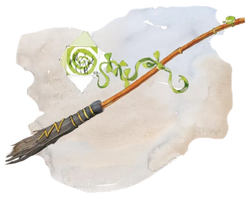The broomstick is a magical device which enables witches and wizards to fly unsupported. The broomstick will travel from one location to the another undetected. In England, Wales, Scotland and Ireland, they are monitored by the Ministry of Magic. They appear throughout the Harry Potter book series and Quidditch Through the Ages.
Every single wizarding home owns at least one broomstick. They are a vital part of wizarding life and the popular wizarding sport of Quidditch. There are many companies who create bespoke and improved types of broomsticks.
History[]
Invention[]
In ancient times, there was no spell that enabled wizardkind to fly unsupported and they had to search for other kinds of transportation. If an Animagi took the rare form of a bird or were able to transform into a bat (but with the small brain of one), then they could have flown.[1]
When wizardkind feared Muggles finding out about the extent of their powers long before the International Statute of Secrecy was enacted, they looked for new kinds transportation that was easy to hide. They realised if they used a household object, they would need no explanation if a Muggle found it. They eventually choose broomsticks because they are portable and inexpensive. The broomsticks were enchanted with spells in order to fly and by 962 A.D., the first broomsticks were invented.[1]
Evolution[]
The early broomsticks had many problems and needed many improvements. They were very uncomfortable since they were made of unvarnished wood knotted together. The charms were very basic and the power and speed and comfort of every broom varied for centuries because they were made by each family or person using the supplies that were available to them.[1]

An early example of a broomstick
Guthrie Lochrin owned a broomstick of thick knotted unvarnished ash and hazel twigs bound on one end. Far from aerodynamic, the charms were very basic and it only moved forward and up and down at one speed. The broomstick was later put in a museum. Lochrin complained of splinters even after a short trip on the broom.[1]
Eventually the brooms improved on comfort enough to the point where people rode them for fun and not only for transportation. They were playing ancient games on them and by the eleventh century, an early known form of Quidditch began to take shape. These brooms were good enough for scoring goals, knocking balls and avoiding collision to the point where players began trying to knock each other off the brooms with boulders.[2]

Effect of the Cushioning Charm (invisible)
By the twelfth century, skilled broom-makers were being noticed and started bartering for their services. This grew in popularity. For example, a skilled broom-maker would exchange their broomstick with a neighbour skilled at potion-making.[1] The quality of broomsticks continued to vary for many centuries but comfort problems were not solved until the nineteenth century. Elliot Smethwyck invented the Cushioning Charm in 1820. Broomsticks were still made by independent wizards but they were incapable of achieving high speeds or having good control at higher heights. The purpose of these brooms were less about the performance and more about the appearance of the brooms.[3]
In 1879, Elias Grimstone created the first racing broom, the Oakshaft 79. It was an improvement on every broomstick before it and broom-makers started researching for the perfect combination of speed, control, high production numbers, appearance, comfort and to make a broom that was good for both sport and transportation.[3]

The Nimbus 2000 invented in 1991
In order to achieve high production numbers, broom-making companies were founded. In 1926, the Cleansweep One was released with the capability of producing good speed and control with comfort and a nice appearance. In 1929, the newly released Comet 140 was even better than that and many other broom manufacturing companies were founded.[3] The pinnacle of early racing broom-making was the invention of the Nimbus Racing Broom Company in 1967. The Nimbus 1000 was exceptional, achieving speeds of 100 miles per hour and 360 point degree turns, making it a very popular broom.[3]
By 1981, companies were creating toy broomsticks for small children to fly.[4] It was thought that only Dark magic could interfere with the performance of a broomstick.[5] Older broomsticks are now vintage pieces and valuable to own. It was popular to discuss what the best broomstick ever is. Everyone wants a broomstick and every household has at least one. The rich are able to afford the best brooms. Flying is a subject taught to every student in their first year at Hogwarts which provides several old broomsticks for them to use. First years cannot bring their own broomstick.[6][7] Broomstick Servicing Kits are also available to purchase.[8]
Manufacturing companies and brooms[]
| Manufacturer or Company | Brooms |
|---|---|
| Unknown | Bluebottle |
| Cleansweep Broom Company |
|
| Comet Trading Company |
|
| Ellerby and Spudmore |
|
| Elias Grimstone | Oakshaft 79 |
| Flyte and Barker | Twigger 90 |
| Leonard Jewkes | Silver Arrow |
| Nimbus Racing Broom Company |
|
Broom Games[]
|
|
Notes and sources[]
- ↑ 1.0 1.1 1.2 1.3 1.4 1.5 Quidditch Through the Ages: The Evolution of the Flying Broomstick
- ↑ Quidditch Through the Ages: Ancient Broom Games
- ↑ 3.0 3.1 3.2 3.3 Quidditch Through the Ages: The Development of the Racing Broom
- ↑ Harry Potter and the Deathly Hallows, Chapter 10
- ↑ Harry Potter and the Philosopher's Stone, Chapter 11
- ↑ Harry Potter and the Philosopher's Stone, Chapter 9
- ↑ Harry Potter and the Philosopher's Stone, Chapter 10
- ↑ Harry Potter and the Prisoner of Azkaban, Chapter 1
